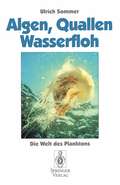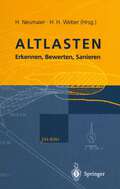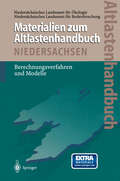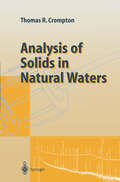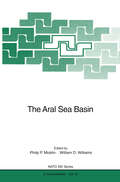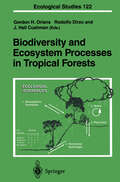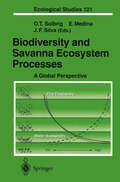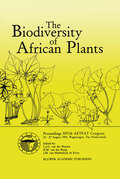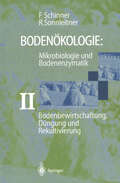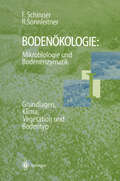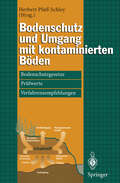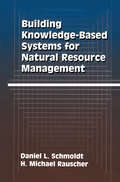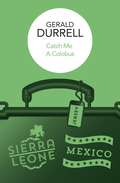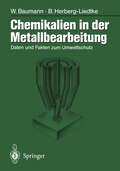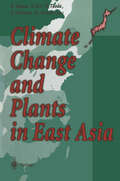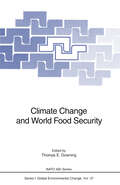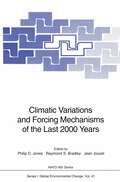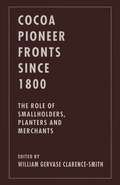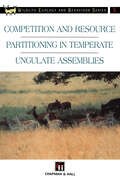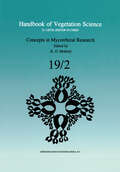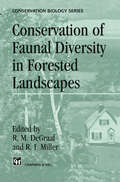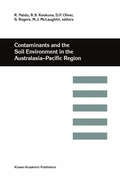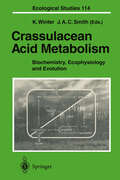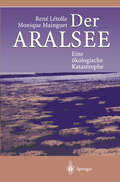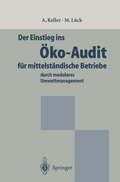- Table View
- List View
Algen, Quallen, Wasserfloh: Die Welt des Planktons
by Ulrich SommerMilliarden winziger Krebse und Larven, Quallen und Algen, Bakterien und Pilze leben in Seen und Meeren. Das Buch führt in ihre faszinierende Formenvielfalt ein und zeigt, welche Rolle sie im Ökosystem der Gewässer spielen. Zahlreiche Beispiele, Abbildungen und Schemata verdeutlichen die komplexe Lebensgemeinschaft in dieser oft mikroskopisch kleinen Welt.
Altlasten: Erkennen, Bewerten, Sanieren
by W. Fresenius G. Mattheß H. Müller-Kirchenbauer W. D. Sondermann K. Storp E. WeßlingEin in Wissenschaft und Praxis der Sanierung von Altlasten erfahrenes Herausgeber- und Autorenteam gibt in diesem Standardwerk einen umfassenden Überblick über die Sanierungstechnologien. Die kritische Darstellung orientiert sich am Stand der Technik und am ökonomisch Machbaren. Alle Beiträge wurden für die dritte Auflage komplett überarbeitet, aktuelle Themen neu aufgenommen.
Altlastenhandbuch des Landes Niedersachsen Materialienband: Berechnungsverfahren und Modelle
by Wolfgang Kinzelbach Axel Voss Randolf Rausch Jean-Pierre Sauty Wen-Hsing Chiang C. Cordes S.Z. FangAnwendungsbezogener Einstieg in die komplexe numerische Modellierung im Altlastenbereich.Zusätzliche CD-ROM mit Programmen für die numerische Modellierung, Beispieldaten und editierbaren Quellen.
Analysis of Solids in Natural Waters
by Thomas R. CromptonAs only a few books have been published on the matter of toxic materials in water it occurred to the author that a comprehensive volume dealing with all aspects of this subject was overdue. In this book there is a complete discussion of world literature on the determination of metals, non-metals, organic substances, organometallic com pounds, together with organic carbon parameters and radioactive elements in river, stream, lake and pond sediments, marine and estuarine sediments, river and sea fish, crustacea and molluscs, phytoplankton and sea and river weeds. Much very detailed work has been carried out on this subject over the past 20 years and a review of this work is timely in view of the increasing interest to chemists, environmentalists and others concerned with the quality of our environ ment. The presence of organic and inorganic substances in river and oceanic sediments is due in part to man-made pollution, and monitoring the levels of these substances in sediment and sediment core samples provides an indication of the time dependence of element concentration over large time spans. Contamination of sediments is found not only in rivers but also in estuarine sediments and sometimes in oceanic sedi ments, and this sediment analysis provides a means of tracking elements from their sources through the ecosystem.
The Aral Sea Basin (Nato Science Partnership Subseries: 2 #12)
by Philip P. Micklin and William D. WilliamsThe Aral Sea Basin, which is located in the central Asian part of the former Soviet Union, is undergoing dramatically rapid and intense environmental change. Pervasive human misuse and overuse of its water, land, and other critical natural resources have led to severe degradation of key ecological systems. This book analyses the environmental, human and economic problems that have arisen and presents recommendations for future research needs. Primary focus is on the drying of the Aral Sea, but related issues of diminished river flow, land and water pollution, and degradation, ecosystem deterioration, and adverse effects on humans are also examined.
Biodiversity and Ecosystem Processes in Tropical Forests (Ecological Studies #122)
by Gordon H. Orians Rodolfo Dirzo J. Hall CushmanAlthough biologists have directed much attention to estimating the extent and causes of species losses, the consequences for ecosystem functioning have been little studied. This book examines the impact of biodiversity on ecosystem processes in tropical forests - one of the most species-rich and at the same time most endangered ecosystems on earth. It covers the relationships between biodiversity and primary production, secondary production, biogeochemical cycles, soil processes, plant life forms, responses to disturbance, and resistance to invasion. The analyses focus on the key ecological interfaces where the loss of keystone species is most likely to influence the rate and stability of ecosystem processes.
Biodiversity and Savanna Ecosystem Processes: A Global Perspective (Ecological Studies #121)
by Otto T. Solbrig Ernesto Medina Juan F. SilvaSavannas are the most widespread ecosystem in the tropics and as such are subjected to great human pressure that may result in massive soil degradation. The book addresses the role of species in the function of savanna ecosystems. It is shown that savannas are enormously diverse and that four factors determine the function of savanna ecosystems: Plant Available Moisture; Plant Available Nutrients; Fire; Herbivores.
The Biodiversity of African Plants: Proceedings XIVth AETFAT Congress 22–27 August 1994, Wageningen, The Netherlands
by Xander Van Der Maesen J. M. Van Medenbach De RooyProceedings of the XIVth AETFAT Congress, 22-27 August 1994, Wageningen, the Netherlands
Bodenschutz und Umgang mit kontaminierten Böden: Bodenschutzgesetze, Prüfwerte, Verfahrensempfehlungen
by Herbert Pfaff-SchleyHandlungsempfehlungen und Praxisbeispiele für den Umgang mit kontaminierten Böden:Erkundung, notwendige Sofortmaßnahmen und langfristige Sanierung für die Folgenutzung.
Building Knowledge-Based Systems for Natural Resource Management
by Daniel L. Schmoldt H. Michael RauscherIf one were forced to use a single key word to describe the decade of the 1980's, a very prominent one would be "technology. " Leading the forefront of tech nology advancement were breakthroughs in electronics. Devices that were uncommon or unknown in 1980 became commonplace, and almost indispens able, by 1989. This trend has continued into the 1990's and it does not seem to be abating in any way. Microwave ovens, video recorders, telephone answer ing machines, compact disc players, computers, and a host of smaller or less sophisticated devices now appear in most households. The development of small and inexpensive computers, i. e. , personal computers, has placed computing resources within reach of many more people. In addition, many traditional, and largely mechanical devices, have been enhanced by electronics. For example, specialized microprocessors are combined with arrays of electronic sensors to control and monitor sophisticated engineering components in most new auto mobiles. In this and many other ways, we are touched by the new electronics in almost every aspect of our daily lives. Initially, personal computers were little more than toys. They contained only a small fraction of the computing power of their immediate ancestors, the mini computers and mainframe computers. However, rapid improvements in integ rated circuit design and chip manufacture produced regular reductions in size and cost of computer components. During the same time, processor speed and sophistication increased.
Catch Me a Colobus
by Gerald DurrellA pot-pourri of humorous animal anecdotes concocted by the famous wildlife lover, leading conservationist and award-winning author, Gerald Durrell. Hectic, hilarious days at his Jersey zoo and forays to various corners of the earth to rescue animal species in danger of extinction provide a series of wonderful stories that are wry, witty and wonderful. Apes get loose, tigers get pregnant and women fall by the droves for a handsome zoo keeper. Endearingly funny, occasionally outrageous, Catch me a Colobos is classic Gerald Durrell.
Chemikalien in der Metallbearbeitung: Daten und Fakten zum Umweltschutz
by Werner Baumann Bettina Herberg-LiedtkeDas Buch gibt erstmals einen Überblick über die in der metallverarbeitenden Industrie eingesetzten Chemikalien. Anwendungsbereiche, Funktionen und alle stoffspezifischen, ökologisch relevanten Informationen werden übersichtlich in Datenblättern dargestellt. Dabei sind alle relevanten Chemikalien berücksichtigt. Dem umfangreichen Datenteil ist eine Darstellung der verwendeten Chemikalien und der damit verknüpften Prozesse, einschließlich Abwasser und Abluft, vorangestellt. Mit diesen Informationen wird das Buch in der metallverarbeitenden Industrie, bei Behörden und vor allem dort sehr hilfreich sein, wo Richt- und Grenzwerte vorgegeben werden sollen oder wo Hersteller oder Verarbeiter mehr über Inhaltsstoffe und deren Umweltwirkungen wissen wollen.
Climate Change and Plants in East Asia
by Kenji Omasa Keiko Kai Hiroshi Taoda Zenbei Uchijima Masatoshi YoshinoEast Asia, with its large, fast-growing population and rapid industrialization, is an important area for global environmental problems, both in terms of the generation of greenhouse gases and the effects of any change in crop yields. The probable climate changes caused by increased concentrations of greenhouse gases and the modeling of plant production, vegetation distribution, phenological events, and lake ecosystems are discussed in this book. Besides providing an overview and synthesis of recent research, this volume shows the importance of analyzing local field data on microclimates, soil environments, the extent of snow cover, and the productivity of mountain vegetation. The possible effects of increasing concentrations of carbon dioxide and rising temperatures on rice yield are shown from controlled environment experiments. This book will be particularly valuable to researchers and students in the fields of ecology, crop science, forestry, and environmental sciences as well as being of interest to anyone concerned with global environmental problems.
Climate Change and World Food Security (Nato ASI Subseries I: #37)
by Thomas E. DowningIn the last half decade since sustainable development became a serious objective, what have we achieved? Are livelihoods more secure? Are nations wealthier and more resilient? Is environmental quality being restored or maintained? These are essential questions of development. Their answers are many, varied between communities and regions, even between individuals. Two years ago, in the aftermath of the Earth Summit and ratification of the Framework Convention on Climate Change, but before the first Conference of Parties, I participated in a panel at the inaugural Oxford Environment Conference on Climate Change and World Food Security. The panel vigorously reviewed issues of resilient development and food security. This book is a product of the Oxford Environment Conference. It takes the essential questions of sustainability as a starting point to focus on present food security and its future prospects in the face of climate change. Why is this book important? First, I believe our goals to end hunger are under threat. We know what to do in many respects, but fail to generate the finances and political will to change the structures that thrive on poverty. Second, I believe concern about the environment has become dangerously separated from the fundamental issues of human deprivation. Third, I believe climate change is a serious threat and I am dismayed at the way nations dither over how to control greenhouse gas emissions and mechanisms to meet the challenge of adverse climate impacts.
Climatic Variations and Forcing Mechanisms of the Last 2000 Years (Nato ASI Subseries I: #41)
by Philip Douglas Jones Raymond Stephen Bradley Jean JouzelA profound knowledge of the past climate is vital for our understanding of global warming. The past 2000 years are both the period which is of most relevance to the next century and that for which there is the most evidence. High-resolution proxy records for this period are available from a variety of sources. Five sections consider dendroclimatology, ice cores, corals, historical records, lake varves, and other indicators. The final two sections cover the histories of various forcing factors and attempt to bring together records from a variety of sources and provide explanations.
Cocoa Pioneer Fronts since 1800: The Role of Smallholders, Planters and Merchants
by William Gervase Clarence-SmithThe livelihood of Third World farmers conflicts with saving the remaining tropical forests. The advantages of growing cocoa in cleared primary forest drive from the fertility of virgin soils and low concentrations of weeds, pests and diseases. The consequent emergence of new 'pioneer fronts' has also been affected by cheap labour, relative commodity prices, pests and diseases, credit resources, entrepreneurship, information, physical infrastructures, and government policies. The dynamism of smallholdings and competitive private marketing over estates and marketing boards is demonstrated.
Competition and Resource Partitioning in Temperate Ungulate Assemblies (Chapman & Hall Wildlife Ecology and Behaviour Series)
by R.J. PutmanRory Putman addresses the question of how, in many temporate ecosystems, diverse and species-rich assemblies of ungulates manage to co-exist despite often quite extensive overlap in ecological requirements. Putman explores the potential for competition, competition tolerance and even positive facilitation amongst the members of such guilds of ungulates. As a central worked example, the author employs data resulting from over 20 years of personal research into the ecology and population dynamics of various large herbivores of the New Forest in Southern England. With these, he applies formal protocols in resource use, evidence for resource limitation and evidence for interaction between species in changing population size over the years.
Concepts in Mycorrhizal Research (Handbook of Vegetation Science #19/2)
by K. G. MukerjiMycorrhiza will be the focus of research and study for the coming decade. Successful survival and maintenance of plant cover is mostly dependent on mycorrhization. During the last decade about ten books have appeared on various aspects of mycorrhiza, including two on methodology. The present book has been compiled to give a complete and comprehensive description of the topic to the students and researchers in botany, applied mycology, biotechnology, forestry and agriculture. The book will also be useful to planners dealing with biofertilizers and forestation. Besides topics of academic interest, the volume includes several aspects which are unique and are written about for the first time, e.g.: Arbuscular Mycorrhizal symbiosis - recognition and specificity; Mycorrhizal Integration and cellular compatibility between Endomycorrhizal symbionts; Cost - economics of existing methodology for inoculum production of vesicular-arbuscular mycorrhizal fungi; Mycorrhiza: Ecological Implications of Plant interactions; Outplanting performance of mycorrhizal inoculated seedlings; Fluorescence microscopy in mycorrhiza studies and Ectomycorrhizal fungi as experimental organism. Other aspects not mentioned above include most recent reviews concerning vesicular-arbuscular mycorrhiza and ectomycorrhizae. The different review chapters have been written by world authorities in their respective specialisations giving more up to date information than is provided anywhere else. This book deals with all major aspects of mycorrhiza, giving structure, ultrastructure, ecology and applications in agriculture and forestry.
Conservation of Faunal Diversity in Forested Landscapes (Conservation Biology #6)
by Richard M. DeGraaf Ronald I. MillerForest wildlife conservation is critically required in many parts of the world today. This book presents a merger between the elements of wildlife conservation and habitat conservation, and explains how these disciplines can be used to promote the conservation of vertebrates in forests around the world.
Contaminants and the Soil Environment in the Australasia-Pacific Region: Proceedings of the First Australasia-Pacific Conference on Contaminants and Soil Environment in the Australasia-Pacific Region, held in Adelaide, Australia, 18–23 February 1996
by R. Naidu R. S. Kookana D. P. Oliver S. Rogers M. J. McLaughlinThe Australasia-Pacific Region supports approximately 50% of the world's population. The last half-century has witnessed a rapid increase in the regional population, agricultural productivity, industrial activities and trade within the region. Both the demand for increased food production and the desire to improve the economic conditions have affected regional environmental quality. This volume presents an overview of the fate of contaminants in the soil environment; current soil management factors used to control contaminant impacts, issues related to sludge and effluent disposals in the soil environment; legal, health and social impacts of contaminated land, remediation approaches and strategies to manage contaminated land, some of the problems associated with environmental degradation in the Australasia-Pacific Region and steps that we need to take to safeguard our environment.
Crassulacean Acid Metabolism: Biochemistry, Ecophysiology and Evolution (Ecological Studies #114)
by Klaus Winter J. Andrew C. SmithCrassulacean acid metabolism (CAM) represents one of the best-studied metabolic examples of an ecological adaptation to environmental stress. Well over 5 % of all vascular plant species engage in this water-conserving photosynthetic pathway. Intensified research activities over the last 10 years have led to major advances in understanding the biology of CAM plants. New areas of research reviewed in detail in this book include regulation of gene expression and the molecular basis of CAM, the ecophysiology of CAM plants from tropical environments, the productivity of agronomically important cacti and agaves, the ecophysiology of CAM in submerged aquatic plants, and the taxonomic diversity and evolutionary origins of CAM.
Der Aralsee: Eine ökologische Katastrophe
by Rene Letolle Monique MainguetDie Besonderheit dieser ersten umfassenden Monographie zur Geschichte und Problematik des Ökosystems 'Aralsee' liegt in deren multidisziplinärer Betrachtungsweise. Die Spannbreite reicht dabei von der Erläuterung der geologischen Entstehung des Aralbeckens über dessen Siedlungs- und Wirtschaftsgeschichte bis hin zur Beschreibung der ökosystemaren Zusammenhänge und deren massive, durch Zivilisation und Ökonomie verursachten Beeinträchtigungen. Neben den Ursachen und Mechanismen, die zu dieser bisher größten durch den Menschen ausgelösten ökologischen Krise führten, gehen die Autoren auch auf die sich daraus ableitbaren Konsequenzen sowie mögliche Gegenmaßnahmen ein.
Der Einstieg ins Öko-Audit für mittelständische Betriebe: durch modulares Umweltmanagement
by Alexander Keller Michael LückDas modulare Umweltmanagement (MUM) ist vor allem für die mittelständische Industrie ein ideales Verfahren zum sukzessiven Aufbau eines betrieblichen Umweltmanagements. In seiner zukunftsweisenden Perspektive kann es stufenweise und überschaubar in ein Umwelt-Audit münden. Das stufenweise Vorgehen ermöglicht dabei eine Adaption an die jeweiligen Gegebenheiten eines Betriebes und erlaubt zudem durch fortwährende Rückübertragung und Kontrolle der Ergebnisse eine ständige Optimierung des Gesamtprozesses.
